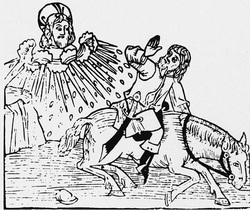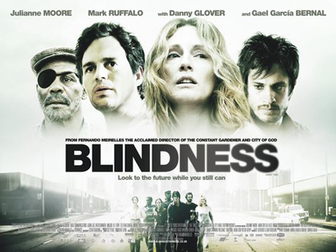Critical Essay Response
“The animalization also becomes manifest as uncleanness. When the epidemic of blindness breaks out, the government protects the population by gathering "together in one place all those infected, and, in adjacent but separate quarters all those who have had any kind of contact with them" (41). It is during this period of segregation that the blind humans become increasingly unclean.”
This excerpt from David Bolt’s critical essay on Saramago’s Blindness struck me because of the usage of the word “unclean”. This reminded me of biblical stories, particularly that of Noah and the Arc. Noah was told to separate the “clean” animals from the “unclean”. They were not categorized this way because of external cleanliness but because of physical differences. This is also the case in Blindness. The patients that have the white blindness are removed from society so that this handicap does not spread. The internal uncleanliness, that is blindness, later becomes an external one amongst the patients in the asylum. The animalization of the patients becomes more obvious as we read of their stay in the asylum.
“…There are many ways of becoming an animal, he thought, this is just the first of them" (112)
This excerpt from David Bolt’s critical essay on Saramago’s Blindness struck me because of the usage of the word “unclean”. This reminded me of biblical stories, particularly that of Noah and the Arc. Noah was told to separate the “clean” animals from the “unclean”. They were not categorized this way because of external cleanliness but because of physical differences. This is also the case in Blindness. The patients that have the white blindness are removed from society so that this handicap does not spread. The internal uncleanliness, that is blindness, later becomes an external one amongst the patients in the asylum. The animalization of the patients becomes more obvious as we read of their stay in the asylum.
“…There are many ways of becoming an animal, he thought, this is just the first of them" (112)
Images of Blindness: "The Conversion of Saul of Tarsus"

"The Conversion of Saul of Tarsus" is a woodcut from 1481. The creator of this piece is anonymous. It is featured in the collection The Illustrated Bartsch. The Conversion of Saint Paul, as depicted in the Christian Bible, refers to the event in the life of Paul of Tarsuswhich led him to become a follower of Jesus. According to the accounts in Acts, Paul was on his way from Jerusalem for Syrian Damascus to arrest followers of Jesus, with the intention of returning them as prisoners for questioning and possible execution. His journey is interrupted when Paul sees a blinding light, and communicates directly with a divine voice.
As he neared Damascus on his journey, suddenly a light from heaven flashed around him. He fell to the ground and heard a voice say to him, "Saul, Saul, why do you persecute me?"
"Who are you, Lord?" Saul asked.
"I am Jesus, whom you are persecuting," he replied. "Now get up and go into the city, and you will be told what you must do."
The men traveling with Saul stood there speechless; they heard the sound but did not see anyone. Saul got up from the ground, but when he opened his eyes he could see nothing. So they led him by the hand into Damascus. For three days he was blind, and did not eat or drink anything. – Acts 9:3-9
This particular piece of artwork reminds me of the beginning of the book Blindness when José Saramago uses a simile depicting horses before the start of a race to describe the cars lined up at the traffic light. This is also the instant when the driver loses his eyesight and goes blind. This painting almost seems a literal translation of the beginning passages of the book. As Saul is riding his horse, he is overcome by blindness from the heavens; as the man is riding in his car, he is overcome with blindness.
"The motorists kept an impatient foot on the clutch, leaving their cars at the ready, advancing, retreating like nervous horses that can sense the whip lash about to be inflicted." (p.1)
"...I am blind, I am blind, he repeated in despair…" (p.2)
As he neared Damascus on his journey, suddenly a light from heaven flashed around him. He fell to the ground and heard a voice say to him, "Saul, Saul, why do you persecute me?"
"Who are you, Lord?" Saul asked.
"I am Jesus, whom you are persecuting," he replied. "Now get up and go into the city, and you will be told what you must do."
The men traveling with Saul stood there speechless; they heard the sound but did not see anyone. Saul got up from the ground, but when he opened his eyes he could see nothing. So they led him by the hand into Damascus. For three days he was blind, and did not eat or drink anything. – Acts 9:3-9
This particular piece of artwork reminds me of the beginning of the book Blindness when José Saramago uses a simile depicting horses before the start of a race to describe the cars lined up at the traffic light. This is also the instant when the driver loses his eyesight and goes blind. This painting almost seems a literal translation of the beginning passages of the book. As Saul is riding his horse, he is overcome by blindness from the heavens; as the man is riding in his car, he is overcome with blindness.
"...I am blind, I am blind, he repeated in despair…" (p.2)

